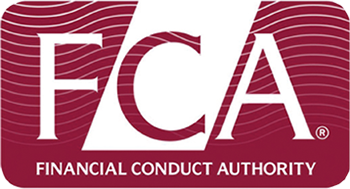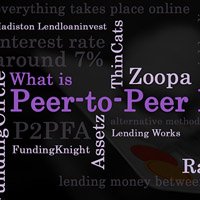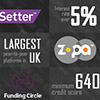What is peer-to-peer lending?
Peer-to-peer lending (P2P), also known as social lending or crowd-funding, is one of the fastest growing markets in the UK. The idea of P2P lending is based on lending money between individuals, or "peers", or to small businesses without the use of official financial institutions such as a bank. In contrast to these official financial institutions borrowers and investors have a benefit of more attractive interest rates.
What is peer-to-peer lending
Peer-to-peer lending can be categorized as unsecured personal loans without the use of official financial institutions such as a bank. We can look on peer-to-peer from two basic points of view as borrower or as an investor. For borrower it is an alternative method of debt financing and for investors interest opportunities how to earn extra money.
How does peer-to-peer lending works?
Gone are the days of arranging appointments in the bank, completing endless forms, checking credit score and waiting for the bank to make a decision whether you are approved for the credit or not. The whole P2P lending process is much simpler. It takes place online: from the registration to the system, through the credit application, to the final money transfer. P2P lending companies’ use various different but very highly automated lending platforms on their websites.
Borrowers: Obtaining a loan, or at least a loan application process, works very similar across all P2P providers. If you are low risk borrower and all your personal data are clear you can get money in two days, but generally providers say up to one week. Let's look at how such a process might look like in 3 simple steps:
- A personalised quote of how much and for how long you can borrow
- Full loan application with complemented data of your personal details (e.g. borrower identity, bank account, employment history, debt, income etc.). Chosen provider normally takes 1 or 2 days to evaluate the application
- Once approved, it is necessary to obtain client's confirmation in order to place your request into the system and display to investors. And now, depending on how attractive you are to investors, you can have your money available within couple of days.
Investors: For investors is the whole process, starting with registration to a first investment, even shorter – for example, RateSetter’s registration guide says that you need only 5 minutes… It is like buying something in e-shop. Off course I mean just a technical process which can be divided into 4 steps:
- Registration and verification
- Putting your money to your new investment account typically by Debit Card or Bank Transfer
- Selecting ideal product (New investors must be very careful here. There are a many products or loans in which you can invest with different risks or interest rates. If you have no experience, you should invest in small amounts and build up your own strategy which suits you the best, but more on that in another article.[link])
- Invest your money
What are the risks?
For loan applicants there is practically no risk. But it is essential for P2P lending companies’ to offer the most trusted and secured applicants to investors. Hence each applicant has its own credit check tools (e.g. borrower identity, bank account, employment history, debt and income) based of which the applicant can set various restrictions when applying for a P2P loan.
Even, repeated or unsuccessful loan applications do not have negative impact on your credit score like it happens when you apply for a new credit via official financial institutions. Just to clarify: using an old traditional way (standard way) you can lose up to 10% of your credit score.
Investors in P2P lending system are burdened with a relatively greater risk. Investors are those who must rely on high-quality credit check from P2P providers and subsequently on the reliability of the borrower, in which they invest their money.
But there are many techniques and tools as possible to protect the invested money. On the one hand it is the behavior of investors and their approach to minimise risk by diversifying their investment across multiple individual or business loans. On the other hand, P2P lending platforms efforts to take steps to minimise the risks by, for example:
- Own credit check of loan applicants;
- Chasing missed payments;
- Requiring surety property or guarantor;
- Legal department for debt collection on defaulters;
- Creating safety funds to cover damages;
- Providing statistics about the behavior of different groups of borrowers;
- Some providers keep their default debts very low, only around 0.5%.
More informations for investors you can find out in article peer-to-peer investing [link].
How much does peer-to-peer loans cost?
The price of loans is affected by the rules of two key factors. At first glance, insignificant but an important factor are the fees that providers charge. These fees are specific to each P2P platform separately.
The second factor that determines the cost of loans and most interested for everyone is the interest rate. Interest rate is very significantly affected by your credit score reflecting on how much of a risk you're seen as.
- If you have a very good credit score, you may be able to borrow at an interest rate of around 7%
- If you have a poor credit score, your interest rate may be pretty high up to 20-30%.
- Applicants with poor credit score could be rejected.
Peer-to-peer comapre to saving account and cach ISA
To compare savings accounts and P2P is not easy as it might seem. Despite various fees and any defects lenders can earn a higher return on their investment of P2P loans than they can with a bank savings account. Let's take a look at comparing savings accounts and P2P programs with fixed-rate for fixed period at 1, 3 and 5 years.
Before we jointly look at the best deals on the market, it is necessary to make a disclosure made of important information regarding the display of interest rates:
- P2P: interest rate after fee and defaults debts and before tax.
- Savings accounts: interest rate before tax
- Cash ISA is tax free.
The best one-year accounts on the market
-
Peer-to-peer
Wellesley & Co.: 3.75% p.a.
RateSetter: 3.7% p.a.
-
Saving accounts
Kent Reliance: 2.1% p.a.
Harrods Bank Ltd: 2.05% p.a.
-
Cash ISA
Al Rayan Bank: 1.9% p.a.
Tesco Bank: 1.75% p.a.
The best three-year accounts on the market
-
Peer-to-peer
RateSetter: 5.5% p.a.
Wellesley & Co.: 4.75% p.a.
-
Saving accounts
Fidor Bank: 2.75% p.a.
Axis Bank: 2.5% p.a.
-
Cash ISA
Virgin Money: 2.25% p.a.
-
The best five-year accounts on the market
-
Peer-to-peer
Wellesley & Co.: 7.0% p.a.
Lending Works: 6.1% p.a.
-
Saving accounts
Agri Bank: 3.15% p.a.
Secure Trust Bank: 3.13% p.a.
-
Cash ISA
Virgin Money: 2.51% p.a.
-
Finally, it is necessary to mention one major drawback of savings accounts. Many of savings accounts have a pretty high minimum required savings amount: £ 1,000 or even £5,000. In P2P is the minimum stake many times smaller and often just as little as £10 to be put in.
Rules and Regulations
Peer2peer finance association
 The Peer2Peer Finance Association (P2PFA) was founded in 2011 by Zopa, FundingCircle and RateSetter as a self-regulatory association for ensuring high minimum standards of protection for consumers in peer-to-peer finance industry.
The Peer2Peer Finance Association (P2PFA) was founded in 2011 by Zopa, FundingCircle and RateSetter as a self-regulatory association for ensuring high minimum standards of protection for consumers in peer-to-peer finance industry.
All members of the P2PFA must adhere rules and operating principles for the transparent, fair and orderly operation of P2P finance. The 3 main objectives are:
- to seek to secure public policy, regulatory and fiscal conditions that enable the UK-based Peer-to-Peer Finance sector to compete fairly and grow responsibly;
- to ensure that Members demonstrate high standards of business conduct, to demonstrate leadership and to promote confidence in the sector;
- to raise awareness and understanding of the benefits and risks of Peer-to-Peer Finance;
Financial conduct authority
 P2P lending is classified as loan-based crowdfunding. As such, it is from 1st April 2014 regulated by the Financial Conduct Authority. Main objectives of this regulation is securing an appropriate degree of protection for consumers and promoting effective competition in the interests of consumers.
P2P lending is classified as loan-based crowdfunding. As such, it is from 1st April 2014 regulated by the Financial Conduct Authority. Main objectives of this regulation is securing an appropriate degree of protection for consumers and promoting effective competition in the interests of consumers.
That means that if you are not satisfied you can make a complaint. In the first instance, you make a complain to the firm running the platform and if you are unhappy with the response and you still feel damaged, you have the right to contact the Financial Ombudsman Service, which can order them to put things right. The service is free to use.
Tax advantage
 Until 2015 there were no tax advantages. But everything starts to change from April 2016. When you earn first £1,000 of peer-to-peer and you are a basic-rate taxpayers then this amount is tax free. If you are a higher-rate taxpayer you can earn maximum of £500 tax-free. At the other end, top-rate taxpayers have no tax benefit from P2P.
Until 2015 there were no tax advantages. But everything starts to change from April 2016. When you earn first £1,000 of peer-to-peer and you are a basic-rate taxpayers then this amount is tax free. If you are a higher-rate taxpayer you can earn maximum of £500 tax-free. At the other end, top-rate taxpayers have no tax benefit from P2P.
Popular peer-to-peer lending sites
Currently there are dozens of P2P lending sites and we will concentrate our focus on each site in separated articles in the future. But it does not prevent us from making a general overview at what awaits us.
In previous section we mentioned 3 biggest P2P companies in UK which are at same time founding of Members of Peer2Peer Finance Association: Zopa, FundingCircle and RateSetter. More information on these companies can be found in the following article Top 3 biggest peer-to-peer lending platforms in UK. Others members of Peer2Peer Finance Association are: Landbay, Lendingworks, LendInvest, Madiston Lendloaninvest, MarketInvoice and ThinCats. All of them will be covered in more detail later.
We should not forget very popular P2P sites, especially for investors due to higher revenues, are Wellesley & Co., eMoneyUnion, Assetz Capital or Rebuilding Society.
Pros of peer-to-peer lending
- Unsuccessful loan application does not have a negative impact on your credit score.
- Everything takes place online via peer-to-peer lending websites or online platforms.
- No relationship between lenders and borrowers.
- Loans are in effect securities that can be sold to other lenders.
- There have been no big horror stories of falling P2P market down in the history (yet).
- P2P lending platforms are highly automated so it doesn't take you much time to do it.
- Investors can start invest with very little amounts (as little as £100 or £10).
- Lower interest rates for borrowers than over traditional financing and high returns for investors than traditional savings accounts pay.
- Since 2013 some P2P lending companies have built up a “secure fund” to protect investors. That is if a borrow goes default you will still get your money back.
Cons of peer-to-peer lending
- Missing payments or defaulting on a loan will affect your credit rating.
- Peer-to-peer lending isn‘t covered by the Financial Services Compensation Scheme (i.e. it isn’t insured).
- The loans are unsecured and are not protected by the government insurance.
- Required self-assessment tax return on HM Revenue & Customs (HMRC) because returns for investors are currently paid without any tax being deducted.
- Many borrowers don't have a good credit rating score to reach for a standard loan in the bank.
- P2P lending is not as liquid as stocks on stock markets. That means that it might take some time to get your portfolio liquidized.
- It is still rather investing than saving and therefore you must be ready that you might lose some of your investments.
- If a borrower have bad credit score investors may not want to fund the whole amount of the loan that is requested.







